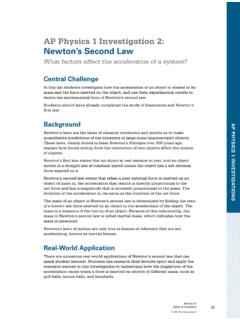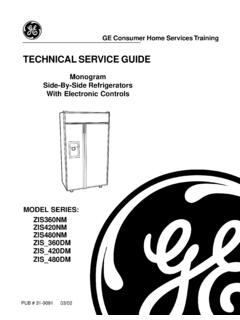Transcription of Core practical 9: Investigate the relationship between the ...
1 Core practical 9 Teacher sheet EDEXCEL Physics Teacher Resource Pack 2 Investigate the relationship between the force exerted on an object and its change of momentum Core practical 9: Investigate the relationship between the force exerted on an object and its change of momentum Objective To determine the momentum change of a trolley when a force acts on it, as a function of time Safety Specification links There are trolleys and masses in motion so practical techniques 1, 2, 3, 4. students should produce a risk assessment for CPAC 2c, 3a, 4b this work. Procedure Notes on procedure 1. Secure the bench pulley to one end of the runway. As the title suggests, this is an This end of the runway should project over the end investigation. You will probably do of a bench, so that the string connecting the mass this early in the year so students are hanger and the trolley passes over the pulley.
2 The likely to need some help recalling mass hanger will fall to the floor as the trolley what they did in Year 12 and moves along the runway. The runway should be developing their own way of tilted to compensate for friction. conducting an investigation. Some 2. Place the slotted mass hanger on the floor and students will need more training but move the trolley backwards along the runway until you might find that some are ready the string becomes tight, with the mass on the for assessment. To make this an floor. Place the light gate so it is positioned in the investigation, students being middle of the interrupt card on the trolley. There assessed for CPAC 2c should draw should be enough space on the ramp to allow the attention to the control of variables trolley to continue so that it clears the light gate not under investigation at that stage. before hitting the pulley.
3 This work can be carried out using an 3. Move the trolley further backwards until the mass air track or dynamics trolleys. It may hanger is touching the pulley. Put the five 10 g be interesting to have some students masses on the trolley so that they will not slide off. use different methods, so that they This is the start position for the experiment. can compare outcomes. It is more appropriate for an investigation if the 4. Record the total hanging mass m. Release the students write a plan, as they can trolley and use the stop clock to measure the time then choose methods and apparatus. T it takes for the trolley to move from the start position to the light gate this should be when the This is a good experiment in which to mass hanger hits the floor. Record the time use uncertainties in support of the reading t on the light gate. Repeat your conclusion.
4 This involves drawing measurements twice more and calculate mean error bars on the graph and two values for T and t and estimate T and t, the further lines of fit. These are then uncertainties in these values. used to calculate the uncertainty in the gradient value. 5. Move one 10 g mass from the trolley to the hanger and repeat step 4. Repeat this process, moving This experiment has been designed one 10 g mass at a time and recording your to use the minimum of apparatus. readings until all of the masses are on the hanger. You can make the following amendments to the design: 6. Measure the combined mass M of the trolley, string, slotted masses and hanger. Measure the - Use two light gates and measure distance d travelled by the trolley. This should be two velocities. the same as the distance fallen by the mass - Use two light gates, one to hanger. Record the length L of the card.
5 Measure the two times and one 7. You can develop the investigation further by taking the time elapsed travelling from more readings after adding an additional mass, for one gate to the other. example 200 g, to the mass of the trolley. - Use a linear air track . practical activities have been safety checked but not trialled by CLEAPSS. Pearson Education Ltd 2016. Users may need to adapt the risk assessment information to local circumstances. This document may have been altered from the original 1. Core practical 9 Teacher sheet EDEXCEL Physics Teacher Resource Pack 2 Investigate the relationship between the force exerted on an object and its change of momentum Answers to questions 1. Use the gradients of the lines of fit and calculate the difference between them. Divide the difference by the gradient of the line of best fit and express the answer as a percentage.
6 The M. computed value for should lie within the uncertainty. g 2. Friction will oppose the motion with the result that the force acting will be reduced, and so the velocity at the light gate will be reduced. This will make the gradient smaller. 3. By using the air track , where there is no contact but considerable air resistance. Or, trolleys can be friction compensated by giving them a downward slope. The slope should be adjusted so that the trolley, when pushed, runs at a constant speed. The success can be judged in part by the percentage uncertainty in Q1. 4. Students should consider how to use the centre's apparatus more effectively. For example, they could discuss the use of a datalogger and multiple light gates. 5. Students may consider the kinetic energy and calculate the transfer from gravitational potential energy as the mass falls. Sample data Mass of trolley, all masses (constant total), string etc.
7 = kg 1. m/kg T/s v/m s mT/kg s The graph of mT against v gives a gradient of M. Calculated value of = g % difference = practical activities have been safety checked but not trialled by CLEAPSS. Pearson Education Ltd 2016. Users may need to adapt the risk assessment information to local circumstances. This document may have been altered from the original 2. Core practical 9 Student sheet EDEXCEL Physics Teacher Resource Pack 2 Investigate the relationship between the force exerted on an object and its change of momentum Core practical 9: Investigate the relationship between the force exerted on an object and its change of momentum Objective To determine the momentum change of a trolley when a force acts on it as a function of time Safety There are trolleys and masses in motion so you should produce an appropriate risk assessment. All the maths you need Recognise and make use of appropriate units in calculations.
8 Use ratios, fractions and percentages. Use an appropriate number of significant figures. Identify uncertainties in measurements and use simple techniques to determine uncertainty when data are combined by addition, subtraction, multiplication, division and raising to powers. Translate information between graphical, numerical and algebraic forms. Plot two variables from experimental or other data. Understand that y = mx + c represents a linear relationship . Determine the slope and intercept of a linear graph. Useful equations: F t = m v shows the impulse of a force is equal to the change in momentum. y = mx + c shows why the intercept should be zero. Equipment dynamics trolley or air track vehicle 5 slotted masses (10 g) and hanger runway or air track light gate and recorder bench pulley stop clock string metre ruler practical activities have been safety checked but not trialled by CLEAPSS.
9 Pearson Education Ltd 2016. Users may need to adapt the risk assessment information to local circumstances. This document may have been altered from the original 1. Core practical 9 Student sheet EDEXCEL Physics Teacher Resource Pack 2 Investigate the relationship between the force exerted on an object and its change of momentum Procedure 1. Secure the bench pulley to one end of the runway. This end of the runway should project over the end of a bench, so that the string connecting the mass hanger and the trolley passes over the pulley. The mass hanger will fall to the floor as the trolley moves along the runway. The runway should be tilted to compensate for friction. 2. Place the slotted mass hanger on the floor and move the trolley backwards along the runway until the string becomes tight, with the mass on the floor. Place the light gate so it is positioned in the middle of the interrupt card on the trolley.
10 There should be enough space on the ramp to allow the trolley to continue so that it clears the light gate before hitting the pulley. 3. Move the trolley further backwards until the mass hanger is touching the pulley. Put the five 10 g masses on the trolley so that they will not slide off. This is the start position for the experiment. 4. Record the total hanging mass m. Release the trolley and use the stop clock to measure the time T it takes for the trolley to move from the start position to the light gate this should be when the mass hanger hits the floor. Record the time reading t on the light gate. Repeat your measurements twice more and calculate mean values for T and t and estimate T and t, the uncertainties in these values. 5. Move one 10 g mass from the trolley to the hanger and repeat step 4. Repeat this process, moving one 10 g mass and recording your readings until all of the masses are on the hanger.













